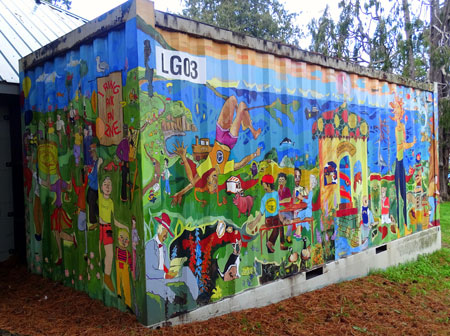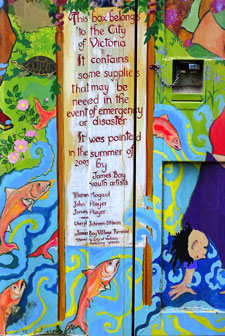Mar
8
Prepare Yourself! Prepare James Bay!
Mar 2016
By Penny Pitcher

"I am here to ease your mind [because] you are my priority," said Kulpreet Munde, Deputy Emergency Co-ordinator of VEMA (Victoria Emergency Management Agency) to those in attendance at the Emergency Preparedness Workshop at James Bay New Horizons on Wednesday, February 18. Victoria has a one in three probability of a major earthquake in the next 50 years which is why VEMA offers these free two-hour Emergency Preparedness Workshops.
Before an earthquake, consider your environment. Know where shut-off valves are for gas, electricity and water. Fasten shelves to the wall. Latch cabinet doors etc. Strap hot water tanks to the wall. More information, resources, games and contests to help families prepare can be found at . Have a plan beforehand as to how you will reconnect – Facebook or texting. Do NOT try to use the phone for local calls except 911 in matters of life or death. Contact someone outside the province to let them know you are okay and then all concerned friends and relatives can contact them. Have a plan in place for collecting children from school because they will not be allowed to leave unless they have been picked up. Plan for your pets. They, too, will be under stress and friendly Fido may snap and snarl and even bite so it might be an idea to muzzle him, or at least, do not let people try to soothe or pet him. Have shoes and socks and flashlight under the bed. If the quake occurs when you are in bed, you don't want to step on a shattered bedside lamp in bare feet.
 Drop! Cover! Hold On! This is the safest thing to do during an earthquake. (This does NOT mean stand in a doorway. Kulpreet spoke of finding people "squished" in doorways. Nor should you run because the shaking will cause you to fall, possibly breaking bones - and who knows what might fall on top of you.) Once the shaking has stopped, count to 60 and crawl out.
Drop! Cover! Hold On! This is the safest thing to do during an earthquake. (This does NOT mean stand in a doorway. Kulpreet spoke of finding people "squished" in doorways. Nor should you run because the shaking will cause you to fall, possibly breaking bones - and who knows what might fall on top of you.) Once the shaking has stopped, count to 60 and crawl out.
If you are in a car, pull over but be sure to avoid power lines, buildings, bridges. Because of the motion of the car, you may not have felt the earth tremble. Further, during an earthquake, the shaking ground may become much less solid, as soil and groundwater combine to form a material that acts like a liquid. This process is called liquefaction. Instead of being solid, the ground beneath the road (or building) becomes semi-solid – impossible to drive on! This is why it is important to take your time, evacuate the building, walk (or cycle) always being aware of the dangers of downed power lines, glass etc. Make your way to a safe spot – Irving Park in James Bay is a reception area - and turn on your battery powered radio for emergency instructions.
IF you can camp in your house, do so. You may not have water or power or sewage, but you still have a roof over your head if your home is still standing. The next best option would be to camp on your property. Obviously, however, there are emergencies that could force you to leave your home – fire, natural gas leak, hazardous materials, a tsunami etc.
In the case of a tsunami which is caused by off-shore quakes, people in low-lying coastal areas are advised to move to higher ground. If the earthquake has lasted longer than a minute, or is particularly strong, a tsunami is a distinct possibility and will arrive in approximately 75 minutes. The highest point here in James Bay is the Checkers Pavilion atop Beacon Hill. Stay there and listen to the radio. Do not return home until told to do so because after the initial wave, others will continue to strike for up to twenty-four hours.
VEMA recommends "Grab and Go" bags. These are bags that contain those items to fill immediate needs while you make your way to your main emergency kit. It is a good idea to keep one in the car and another at work, with the main supply at home. These "Grab and Go' bags should contain shoes and socks, water, granola bars, contact information, a list of medications – even a small First Aid kit.
Your main emergency kit should contain enough food and water etc. to last seven days. Even though three days is often suggested as being sufficient, it may take much longer for help to arrive. Using slides taken of the 6.3 earthquake in Christchurch, New Zealand in 2011, Kulpreet stressed the fact that even when the earthquake has shaken itself out, the period of recovery is very long. Four litres of water per person per day is also recommended. Fill your emergency kit with food that you actually enjoy, keeping in mind any dietary requirements. Ensure that the shelf life of the items is sufficient. It is a good idea to rotate the kits every six months – perhaps using the time changes as a reminder. Think also of hygiene – hand sanitizer, toilet paper etc. Then there is the necessity to have copies of insurance documents and other important data – these could be stored on memory sticks, hard drives, in the cloud etc. Since ATM machines will not be working, have small bills and coins on hand – no one is going to have change for a $100 bill! Check out for more ideas.
Also available from VEMA are guides on how to prepare, complete with check lists, signs for your window to indicate whether you are OK or need HELP, and 'Recipe Cards' which have won International Awards in preparedness competitions around the world. These recipes for disaster cards cover PREPARE AT HOME, PREPARE AT WORK, PREPARE YOUR PET.
Across Victoria, there are 12 large containers, each close to a facility which could be used as a reception site. There is a very colourful one in Irving Park beside the James Bay New Horizons. This container is filled with paperwork, but also cots, blankets, cooking supplies etc. – all those things needed for the Evacuee Assistance Team to transform the facility (in this case, New Horizons) into a Group Lodging or Reception Centre. If New Horizons should be deemed unstable, then the contents would be taken to another location.
VEMA supports seven volunteer-based teams, including Cyclist Response, Evacuee Assistance, Urban Search and Rescue, and Radio Communications. More information as to how you can participate can be found at
James Bay, Vancouver Island is HOME. That said, there ARE risks inherent to living here. Take steps NOW to ensure that you understand those risks and have done your best to mitigate them.
